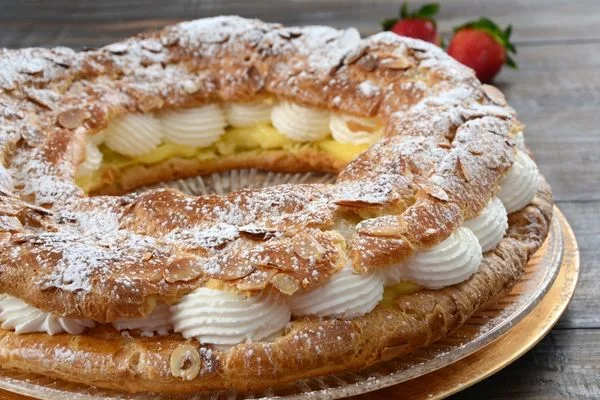Paris–Brest cake is a decadent dessert that has delighted taste buds for over a century. This circular pastry, made of choux dough, praline cream, and sliced almonds, was created in 1910 by French pastry chef Louis Durand.
The dessert was named after a famous cycling race that took place between the French cities of Paris and Brest, hence its distinctive circular shape resembling a bicycle wheel.
Over the years, Paris–Brest cake has become a beloved classic in French cuisine, with countless variations and adaptations created by pastry chefs all around the world.
In this article, we’ll delve into the rich history of Paris–Brest cake and discover its evolution into the sweet and savory delight that it is today.

The History of Paris–Brest Cake: From Inception to Perfection
The invention of Paris–Brest cake is credited to Louis Durand, who was the head pastry chef at the prestigious French pastry shop, Maison Durand. He created the dessert to honor the cyclists participating in the Paris–Brest–Paris race, a grueling 1200-kilometer race that took place every four years.
Durand’s inspiration for the cake’s shape came from the wheel of a bicycle, with two round choux pastry shells representing the start and end points of the race, and a praline cream filling in the middle symbolizing the cyclists’ journey through the Breton countryside.
The first Paris–Brest cake was an instant success, and soon became a favorite among the race participants and spectators alike. The pastry’s unique shape and delicious flavor made it a popular dessert in France and beyond, and it soon became a fixture in French pastry shops and bakeries.
Evolution of Paris–Brest Cake: Creative Variations and Innovations
Over the years, Paris–Brest cake has undergone numerous creative variations and innovations, each one adding a unique twist to the classic recipe.
One popular variation is the addition of fruit, such as raspberries, strawberries, or peaches, to the praline cream filling. This adds a burst of freshness and color to the dessert, while still retaining the traditional flavor profile.
Another variation is the use of different types of nuts, such as hazelnuts, walnuts, or macadamia nuts, in the praline cream filling. This adds a rich, nutty flavor to the pastry, and can also provide a satisfying crunch.
More recently, pastry chefs have experimented with savory versions of Paris–Brest cake, using ingredients such as smoked salmon, cream cheese, and dill. These innovative twists on the classic dessert have been embraced by food enthusiasts, who appreciate the creativity and boldness of these variations.
FAQs
The traditional filling for Paris–Brest cake is praline cream, made of butter, sugar, ground almonds, and hazelnuts.
Paris–Brest cake is shaped like a bicycle wheel, with two round choux pastry shells sandwiching a praline cream filling. The pastry is typically garnished with sliced almonds and powdered sugar.
The dessert is named after the Paris–
